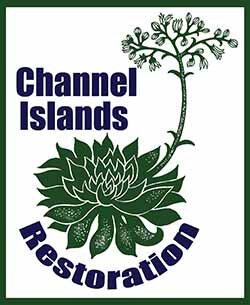CIR volunteers on Santa Cruz Island in 2002
Although the program had expanded into regular monthly trips with large volunteer groups and grant funding, CIR was still very much the “Duke and Ken Show,” as some people began calling it.
It would be several years before CIR needed to hire employees, because Duke and Ken could rely on the help of hundreds of volunteers a year.
This made for a very economical operation, and the grant funding that was supposed to pay for twelve trips, lasting just a year, actually paid for almost double that.
In 2005, the first of many school groups began working with CIR on Santa Cruz Island.
That same year, David Chang from the County of Santa Barbara, hired CIR to work on two important invasive plant removal projects.
One was on Santa Rosa Island, where CIR led volunteer groups surveying for, and removing a thistle listed as a “noxious weed” by the State of California.
This multi-year project marked the first time CIR worked outside of Santa Cruz Island.
In later years, CIR led volunteers to plant natives on Santa Rosa and to install fencing around sensitive plants to protect them from grazing by non-native deer and elk.
Recently, CIR has been removing this fencing now that the non-native animals are gone.
We also work in the island nursery, and we continue to plant natives.
With funding arranged by David Chang, CIR began a large project to supervise the removal of giant reed (“
Arundo”
) from three miles of the Carpinteria Creek watershed with the California Conservation Corps.
This was the first time that CIR was hired to work on a mainland project.
In 2007, CIR was hired by the Land Trust of Santa Barbara County to remove
Arundo
from the Refugio Creek watershed.
The following year, CIR hired employees to help with that project, including Kevin Thompson, who later became the CIR Operations Manager.
The Arundo removal at the Carpinteria and Refugio watersheds (plus others that followed) were large-scale projects requiring equipment, paid personnel and expertise.
CIR continued to work with hundreds of volunteers each year, on projects elsewhere, but the Arundo projects were not suited to volunteers.































